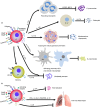Lung-resident γδ T cells and their roles in lung diseases
- PMID: 28555812
- PMCID: PMC5506441
- DOI: 10.1111/imm.12764
Lung-resident γδ T cells and their roles in lung diseases
Abstract
γδ T cells are greatly enriched in mucosal and epithelial sites, such as the skin, respiratory, digestive and reproductive tracts, and they are defined as tissue-resident immune cells. In these tissues, the characteristics and biological roles of γδ T cells are distinguished from each other. The lungs represent the most challenging immunological dilemma for the host, and they have their own effective immune system. The abundance of γδ T cells, an estimated 8-20% of resident pulmonary lymphocytes in the lung, maintains lung tissue homeostasis. In this review, we summarize the recent research progress regarding lung-resident γδ T cells, including their development, residency and immune characteristics, and discuss the involvement of γδ T cells in infectious diseases of the lung, including bacterial, viral and fungal infections; lung allergic disease; lung inflammation and fibrosis; and lung cancer.
Keywords: cancer; infection; inflammation; lung; tissue-resident; γδ T cells.
© 2017 John Wiley & Sons Ltd.
Figures


References
-
- Bonneville M, O'Brien RL, Born WK. γδ T cell effector functions: a blend of innate programming and acquired plasticity. Nat Rev Immunol 2010; 10:467–78. - PubMed
-
- Lu H, Li DJ, Jin LP. γδT cells and related diseases. Am J Reprod Immunol 2016; 75:609–18. - PubMed
-
- Carding SR, Egan PJ. γδ T cells: functional plasticity and heterogeneity. Nat Rev Immunol 2002; 2:336–45. - PubMed
-
- Asarnow DM, Kuziel WA, Bonyhadi M, Tigelaar RE, Tucker PW, Allison JP. Limited diversity of γδ antigen receptor genes of Thy‐1+ dendritic epidermal cells. Cell 1988; 55:837–47. - PubMed
-
- Korn T, Petermann F. Development and function of interleukin 17‐producing γδ T cells. Ann N Y Acad Sci 2012; 1247:34–45. - PubMed
Publication types
MeSH terms
Substances
LinkOut - more resources
Full Text Sources
Other Literature Sources
Medical
Molecular Biology Databases

